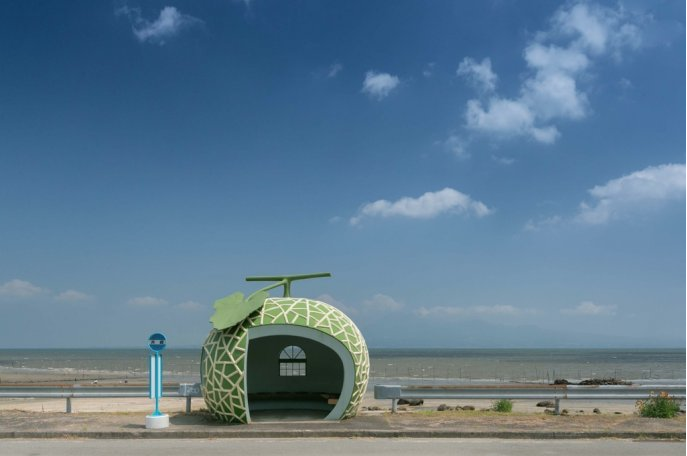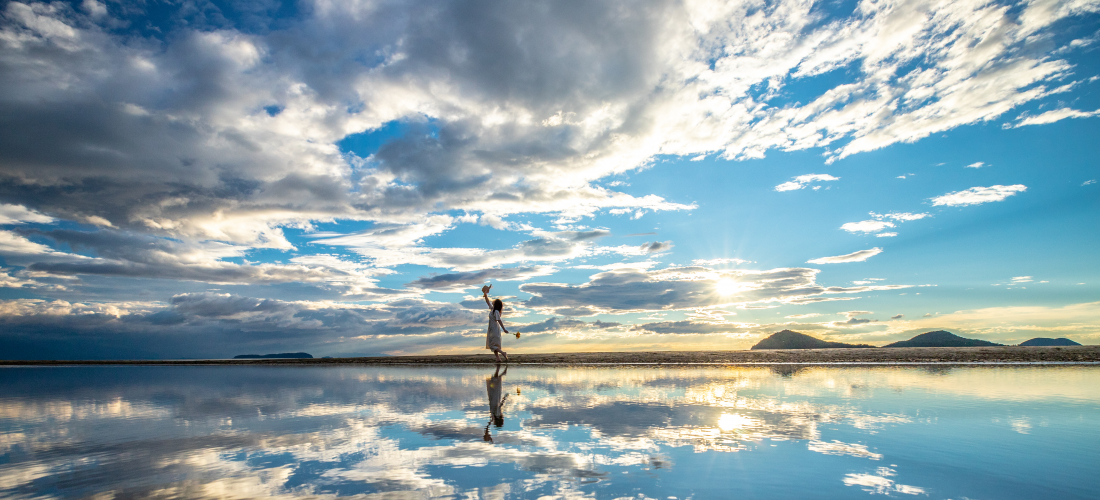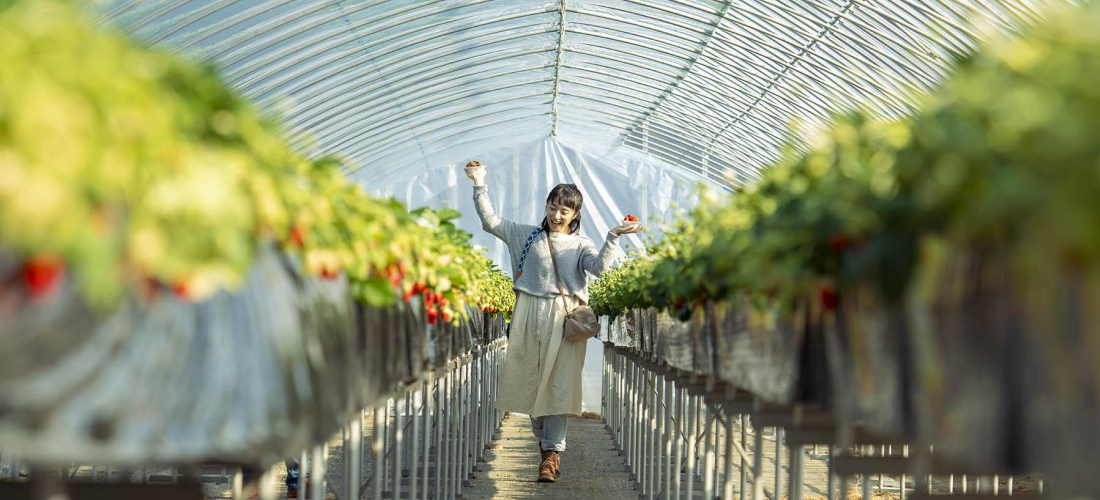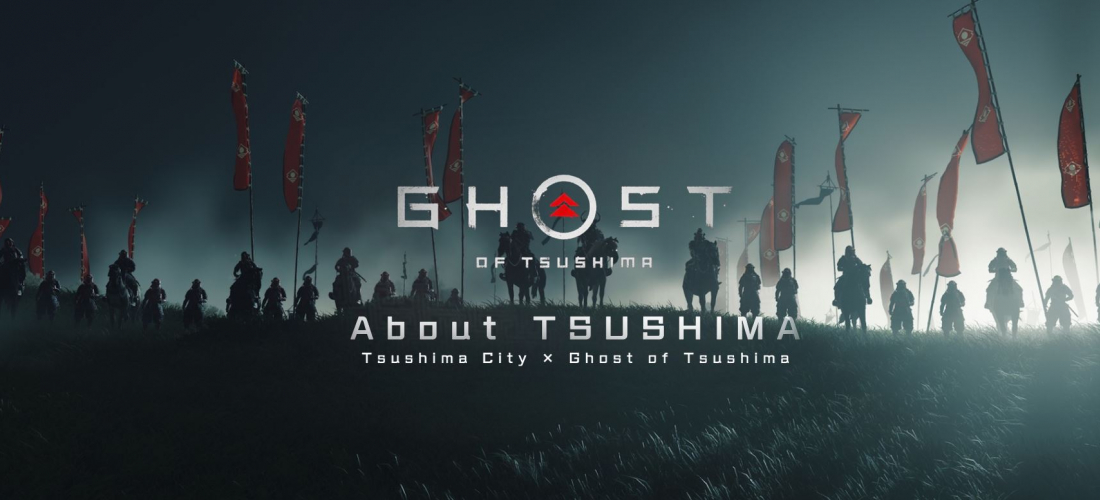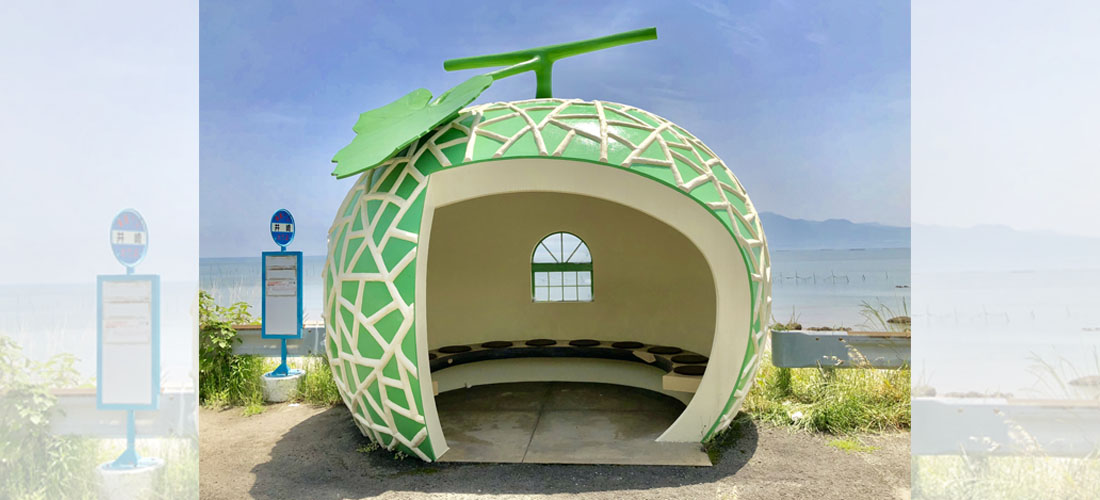
CONTENTS
Surrounded by the blue sky and blue seas, spotting a giant melon in the distance might make you think you’ve accidentally driven right into fairyland. But this dreamy coastal scene isn’t from any fairytale, and it’s not a mirage. Take a bus ride along the shore in Nagasaki’s Isahaya City, and the giant fruits you see are bus stops around the Konagai area, for your everyday transportation needs. (That doesn’t mean spotting this cute fruit doesn’t still feel a little magical!) Here’s how to check them out…
We've introduced you to some of Japan's more magical coastal views before, from the dreamy sunsets of Enoshima to the unreal seaside sand dunes of Tottori, but Isahaya City's shores have their own unique tranquility. With the calm waters and the giant fruit dotting the roadside, this Nagasaki scene looks like a scene from a movie, somewhere between the styles of Disney and Studio Ghibli.
If you want to see these fruits for yourself, and maybe take a couple of enchanting snapshots for your instagram, let us tell you a little bit more about the place, and how to get there!
Once Upon a Time, 30 Years Ago, This Fruity Tale Began
This part of Nagasaki, a prefecture on Japan's southern island of Kyushu, is home to a popular "insta-bae" (インスタ映え) spot, or in other words, it's big on instagram. Drive down Japan National Route 207, winding your way along the edge of the Ariake Sea, and you'll find 16 bus stops shaped like bright, adorable, and truly giant fruits. With the bus stops' recent explosion of popularity on social media, you might think they were constructed recently just for that purpose, but in truth these bus shelters have been around since the 1990s.
As part of the 1990 Nagasaki Travel Expo, the Konagai area of Isahaya City thought to construct the cute bus stops as a way of joining in on the fun, at the same time as teaching visitors about the area. You see, these fruits aren't just randomly chosen, they're all local agricultural specialties! The bus shelters come in five shapes: strawberry, mandarin orange, melon, tomato, and watermelon, all of which are particularly delicious in the area. Visitors to the expo loved the cute buildings so much, the bus stops have remained the same ever since.
To bring Nagasaki back to the fairytale world, Cinderella would be proud, as the idea for the huge fruit structures came from her pumpkin carriage! The lovely bus stops have been around for decades now, so thanks to the recent popularity boom, the local government has been giving them a little TLC. With a fresh coat of paint and a few little repairs, they look juicy enough to bite right into (but please don't, your teeth won't thank you). Perhaps the next step can be to help us all fulfill our Cinderella dreams, and make the buses themselves a little more… squash-shaped.
We can dream, right?
Can You Make it to Every Stop in One Fell Swoop?
Of the 16 bus stops, 14 of them are along National Route 207, with two more around Nagasato Station a little ways away. You can probably rent a car and stop at many of the fruits, and if you want to move around on your own schedule, it might be the easiest way to go. But these are bus stops after all, visiting them using public transportation only seems logical. The bus route stops at two train stations, Nagasato and Konagai, so you can take a train over and hop on the bus. But beware, according to Japanese blogger Colorful Camera Life, the trains that stop at these stations actually come pretty infrequently. You'll want to look at the schedules and think out your itinerary a little bit beforehand.
Among the 14 coastal bus stops, two stand out as popular destinations. The Izaki Bus Stop is melon-shaped, and known for its background of scenic sea views. It's usually the first stop you'll see pictures of! The other famous one is the Amidazaki Bus Stop, which is mandarin orange-shaped. Its claim to fame is that it appeared in a series of ads for Japanese popsicles. You too can take an orange popsicle with you and pretend you're on TV.
The tricky part about all this is that although these two bus stops are only a 7 minute ride apart, the bus only comes once an hour. Since they're along the highway, it's not a very safe place to go on a long walk, and there isn't really anywhere to park for a while nearby. So you'll have to just plan an hour's worth of fun! Take your time coming up with sillier and sillier poses, you'll be sure to get some good pictures! Or, if your pockets are deep enough, and you're confident enough in your Japanese, you can always rely on taxis to move you around in a flash.
So, What’s the Best Way to Do It?
Considering all the little inconveniences we just mentioned, you might be wondering if it really is possible to see some of these bus stops without driving yourself crazy. Well, we recommend you follow the example of the Japanese blogger we mentioned before, Colorful Camera Life. Instead of trying to see all the bus stops, take a more relaxed route and just admire some of the most impressive stops. Get off the train at Konagai Station, and then take the bus over to the Izaki Bus Stop. There you can get your own calming shot of the giant cantaloupe in front of the sea, and from that spot it's actually not too far to a cute strawberry-shaped bus shelter. Next you can move on to Amidazaki, and pretend you're a star of the small screen for a day. Then you can take the bus back to the station, and get going to your next adventure!
To plan your schedule perfectly, take a look at the bus stop timetables for the area (in Japanese only, unfortunately).
Fresh strawberries and watermelon in front of a glittering sea view, it's definitely a good trip for the summer. For the perfect outing, and maybe the perfect photo, bring some fruit with you to snack on while you're there! (Obviously, don't forget your camera!)
If you'd prefer your giant fruit to be more of the autumn variety, Japan is of course the place to see some of Yayoi Kusama's giant pumpkin sculptures. If you're in Tokyo, stop by her museum to check those out.
Or add us on Instagram and Facebook to share your pictures of Japan. 🗾
Details
NAME:Izaki Bus Stop, Amidazaki Bus Stop
MAP
ACCESS:Konagai Station
PROFILE
Follow us @Japankuru on Facebook, Instagram, and Twitter!
COMMENT
FEATURED MEDIA
VIEW MORE
Which snacks make the best Japanese souvenirs?~ Jaga Pirika ~ 일본과자 선물 뭐하지?~자가피리카 편~ #pr #calbee #jagapokkuru #japanesesnacks #japanesefood #japanesesouvenir #japantravel #japantrip #naritaairport #hokkaido #나리타국제공항 #일본여행선물 #흔하지않은기념품 #일본쇼핑리스트 #일본과자추천 #고구마과자 #일본간식추천 #일본면세점쇼핑 #개별포장 #일본감자칩 #도쿄나리타공항면세점 #현지인추천 #일본여행 #일본기념품리스트 #자가포쿠루 #자가피리카

Asakusa's Sanja Matsuri, one of the biggest festivals in all of Tokyo, is almost here! Make sure you check out the festival route so you don't miss all the festivities this May. #asakusa #sanjafestival #sanjamatsuri #asakusashrine #sensoji #sensojitemple #japanesefestival #shintoshrine #japaneseculture #tokyo #tokyotrip #tokyotravel #asakusasightseeing #matsuri #japantrip #japantravel #springinjapan #tokyotravel #japankuru #산자마츠리 #아사쿠사 #일본마츠리 #일본여행 #일본5월

Odaiba's DiverCity Tokyo Plaza is home to the famous real-size 20m-tall Unicorn Gundam, and the popular shopping center has even more Gundam on the inside! Check out the Gundam Base Tokyo on the 7th floor for shelves upon shelves of Gunpla, and the Gundam Base Tokyo Annex on the 2nd floor for cool anime merchandise. Both shops have tons of limited-edition items! #pr #odaiba #tokyo #tokyotrip #japantrip #japantravel #PR #divercity #divercitytokyoplaza #tokyoshopping #gundam #unicorngundam #gundambasetokyo #anime #otaku #gunpla #japankuru #오다이바 #다이바시티도쿄 #오다이바건담 #건담 #일본건담 #건프라 #건담베이스도쿄

Evangelion, in miniature!? Tokyo's SMALL WORLDS Miniature Museum is actually a must-see for anime lovers, thanks to the tiny Evangelion Hangar and Tokyo-III... plus a whole universe of other scenes both real and fictional. #smallworlds #smallworldstokyo #tokyotrip #tokyotravel #evangelion #eva #anime #miniature #miniatures #animefigure #japantrip #japantravel #에반게리온 #스몰월드 #에반겔리온 #スモールワールズ #오다이바 #아리아케

Have you sat down for a snack at Sumida Aquarium yet? This aquarium next to Tokyo Skytree is known for its penguins and garden eels, but we can't get enough of their cute snacks! There are lots of good seats around the aquarium, too, so it almost feels like one big cafe. 🐧 • Find out more at Japankuru.com! (Link in bio.) • #japankuru #sumidaaquarium #skytree #tokyoskytree #solamachi #sumida #tokyo #tokyotrip #tokyotravel #aquarium #japanesesweets #themecafe #すみだ水族館 #Japan #日本 #일본 #Japon #ญี่ปุ่น #Japão #япония #japantravel #日本旅行 #日本旅遊 #japan_of_insta #japantrip #traveljapan #japan🇯🇵 #igerstokyo #explorejapan

For anime fans, the Evangelion areas at Small Worlds Miniature Museum are a must see! The tiny miniature people in the Evangelion Hangar look like ants beneath the moving Unit-01, Unit-00, and Unit-02! And over in Tokyo-III, characters like Shinji, Rei, and Katsuragi live life on a miniature scale. #odaiba #tokyo #tokyotrip #japantrip #japantravel #ariake #smallworlds #miniaturemuseum #smallworldstokyo #tokyotravel #evangelion #eva #anime #miniature #miniatures #animefigure #japankuru #스몰월드 #에반게리온 #오다이바 #오다이바관광 #오다이바스몰월드 #미니어쳐


